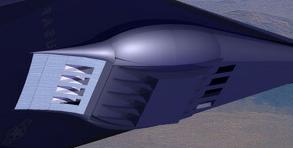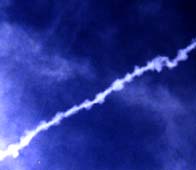Liquid methane or liquid hydrogen is ejected onto the fuselage, where the fuel mist is ignited, possibly by surface heating. The PDWE works by creating a liquid hydrogen detonation inside a specially designed chamber when the aircraft is traveling beyond the speed of sound. When traveling at such speeds, a thrust wall (the aircraft is traveling so fast that molecules in the air are rapidly pushed aside near the nose of the aircraft which in essence becomes a wall) is created in front of the aircraft. When the detonation takes place, the airplane's thrust wall is pushed forward. This process is continually repeated to propel the aircraft. From the ground the jet stream looks like "donuts-on-a-rope".

|
Quoted below is a small description of how a PDWE would accelerate a vehicle towards the hypersonic regime.
"...use a shock wave created in a detonation - an explosion that propagates supersonically- to compress a fuel-oxidizer mixture prior to combustion, similar to supersonic inlets that make use of external and internal shock wave for pressurization."
Not much is known about Pulse Detonation Wave technology, but there have been quite a few reports and sightings of mysterious aircraft using propulsion technology unlike any heard or seen before.
On February 25, 26, and 27, 1992, there were night-time sightings of an unknown aircraft with a "diamond-pattern" of lights at Beale Air Force Base, which was thought to be the Aurora aircraft. The aircraft had a distinctive engine noise, described as "a very, very low rumble, like air rushing through a big tube." On the night of February 26, what was thought to be a ground test of Aurora's propulsion systems took place. A series of booms was heard and described as similiar to "artillery fire" and "deep bass notes, not like sonic booms." It was thought these were "light-off" tests of the engines. It was speculated that the aircraft was using Pulse Detonation Wave Engines. The noise and low frequency would, it was said, be consistent with PDWE technology.
It has also been noted that despite the famous "Donuts-on-a-rope" air contrails not being consistent with Aurora's propulsion system, theses contrails can be produced by a PDWE operating outside of its specified parameters.

|
Although the observations recorded of vehicles with an unusual trailing contrail and noise are intriguing, they are also difficult to reconcile with one another. While many observers agree on the unusual sounds created by these vehicles, a range of descriptions are provided as to the nature of these sounds. The pulsating tone emanating from these sightings has been taken as an indication of the use of some form of pulse detonation wave engine. Some observers report a characteristic frequency as high as 60 Hertz, while others suggest a frequency as low as 1 Hertz.
But a technical analysis of pulse detonation wave engines suggests that engines operating at the thrust levels associated with military aircraft would operate between 100 and 200 Hertz (pulses per second). While doppler shifting may reconcile this value with the reported 50-60 Hertz pulsation, it is more difficult to reconcile this with the reports of a 1 Hertz pulsation.
It is also difficult to reconcile a pulse rate of 100-200 Hertz with the observed donut-on-a-rope contrails. The association of these contrails with a PDWE would seem to be predicated on the observation that each "donut" is a product of a single pulse detonation. Based on published photographs, the "donuts" appear to be approximately 100 meters apart. Assuming a detonation pulse rate of 100 Hertz, this would imply a velocity of 10 kilometers per second, roughly Mach 36 which is 1.5 times orbital velocity. While it is asserted that the Aurora spyplane is a high-speed vehicle, this is at least four times faster than the speeds normally associated with this aircraft.
In addition, a closer examination of the published photographs reveals a significant irregularity in the spacing between the donuts on the rope. This would seem to be inconsistent with the normal functioning of a pulse detonation wave engine.